Physics 60 Interference of Light (8 of 8) Glass Plates
TLDRThe lecture explores the interference of light using an example involving two glass plates with a human hair creating an air gap. Light reflects off the plates, and the resulting interference patterns, dark fringes, are analyzed to determine the hair's thickness. By calculating the path length difference and accounting for phase shifts at the boundaries, the thickness of the air gap, and thus the hair, is deduced to be 2.75 micrometers using the average wavelength of visible light. This method demonstrates a practical approach to measuring the thickness of thin objects.
Takeaways
- 🌟 The lecture discusses the interference of light using the example of two glass plates with a small hair creating an air gap between them.
- 🔍 Light passes through and reflects off the glass plates, creating two rays that interfere with each other based on their phase relationship.
- 🌈 When the reflected rays are in phase, a bright light is observed, but when they are out of phase by half or full wavelengths, dark fringes appear.
- 🔢 The number of dark fringes visible (12 in this case) can be used to determine the thickness of the air gap, and thus the hair.
- 📏 The extra distance traveled by the second ray compared to the first is twice the thickness of the air gap, which increases as the gap widens.
- 🌀 There is no phase shift at the top boundary (glass to air) due to the lower to higher index of refraction, but there is a phase shift at the bottom (air to glass).
- 📉 The initial phase difference between the two rays is half a wavelength due to the phase shift experienced by one ray and not the other.
- 🚫 Destructive interference occurs at the beginning where the gap is minimal, due to the half-wavelength phase difference.
- 🔄 For each fringe, the extra distance traveled by the second ray increases by one wavelength, leading to constructive or destructive interference depending on the phase.
- 📐 The 12th fringe corresponds to an extra distance of 11 wavelengths, which equals twice the thickness of the air gap at that point.
- ⚖️ The thickness of the hair can be calculated using the average wavelength of visible light (500 nm) and the number of fringes observed.
- 🔎 The calculated thickness of the hair is 2.75 micrometers, demonstrating a method to measure very thin objects using interference patterns.
Q & A
What is the phenomenon being discussed in the lecture?
-The lecture discusses the phenomenon of light interference, specifically using the example of two glass plates with a small hair creating an air gap between them.
Why does the air gap between the glass plates create an interference pattern?
-The air gap causes light to reflect off the top and bottom boundaries of the plates, creating two rays of light that can interfere with each other, forming bright and dark fringes.
What determines whether the interference is constructive or destructive?
-The interference is constructive when the two reflected rays are in phase, resulting in bright light, and destructive when they are out of phase by half a wavelength or an odd multiple of half a wavelength, resulting in dark fringes.
How many dark fringes are visible to the observer in the example?
-In the example, there are 12 dark fringes visible to the observer.
What is the relationship between the extra distance traveled by the second ray and the thickness of the air gap?
-The extra distance traveled by the second ray is always twice the thickness of the air gap between the two plates.
Why is there a phase shift when light goes from air to glass but not from glass to air?
-A phase shift occurs when light goes from a lower to a higher index of refraction. Since air has a lower index of refraction than glass, there is a phase shift when light goes from air to glass.
What is the initial phase difference between the two rays when the gap between the plates is minimal?
-The initial phase difference is half a wavelength (Lambda / 2) due to the phase shift experienced by the ray reflecting off the bottom surface.
How does the extra distance traveled by the rays relate to the formation of fringes?
-For each fringe, the extra distance traveled by the rays increases by a whole wavelength, leading to constructive or destructive interference depending on whether the path length difference is an integer multiple of a wavelength.
What is the formula used to calculate the thickness of the hair based on the number of fringes observed?
-The thickness of the hair is calculated using the formula: thickness = (number of wavelengths * average wavelength of light) / 2.
What is the average wavelength of sunlight used in the example, and what is the calculated thickness of the hair?
-The average wavelength of sunlight used in the example is 500 nm. The calculated thickness of the hair is 2.75 micrometers.
How can the method described in the lecture be used to measure the thickness of very thin objects?
-By placing two glass plates together with the thin object in between and counting the number of fringes, one can measure the thickness of the object using the principles of light interference.
Outlines
🔬 Light Interference with Glass Plates and Human Hair
This paragraph discusses an experiment involving light interference using two glass plates with a human hair inserted to create an air gap. The lecture explains how light rays reflect off the glass plates' surfaces, creating bright and dark fringes based on whether the reflected rays are in phase or out of phase. The presence of the air gap causes a path length difference, which, combined with a phase shift at the glass-air boundary, results in destructive interference at certain points. The paragraph concludes with a method to calculate the thickness of the hair based on the number of observed dark fringes and the average wavelength of visible light, using the formula for constructive and destructive interference.
📏 Calculating Hair Thickness Using Interference Fringes
The second paragraph continues the discussion on light interference, focusing on calculating the thickness of the human hair used in the experiment. It explains that the extra distance traveled by the light ray reflecting from the bottom surface, which includes a phase shift, results in destructive interference at specific fringes. The paragraph outlines the process of determining the thickness of the hair by equating the total extra distance traveled at the 12th fringe (11.5 wavelengths) to twice the thickness of the air gap. Using the average wavelength of sunlight (500 nm), the hair's thickness is calculated to be 2.75 micrometers. The paragraph concludes by suggesting that this method could be a practical way to measure the thickness of very thin objects.
Mindmap
Keywords
💡Interference of Light
💡Glass Plates
💡Air Gap
💡Phase
💡Destructive Interference
💡Phase Shift
💡Fringes
💡Wavelength
💡Path Length Difference
💡Visible Light
💡Micrometers
Highlights
Introduction to the concept of light interference using glass plates.
Explanation of the setup involving two glass plates with a small hair creating an air gap.
Description of light behavior through the glass plates and the resulting reflections.
Observation of bright light due to in-phase reflections and dark fringes due to out-of-phase reflections.
The significance of the 12 visible dark fringes in determining the thickness of the human hair.
Calculation of the extra distance traveled by the second ray compared to the first ray.
Phase shift considerations at the boundaries between glass, air, and the impact on interference.
Destructive interference at the beginning due to a half-wavelength phase difference.
Incremental path length differences corresponding to each fringe observed.
The 12th fringe's extra distance traveled equates to 11 wavelengths, correlating to the hair's thickness.
Use of visible light wavelength, approximately 500 nm, for the calculation of hair thickness.
Final calculation resulting in the hair thickness being 2.75 micrometers.
The methodological approach to measuring thin objects using glass plates and fringe counting.
Review of the methodology for understanding the relationship between extra distance traveled and the thickness of the air gap.
Emphasis on the importance of phase shifts in the interference pattern observed.
The practical application of this method for measuring the thickness of thin objects like human hair.
Transcripts
Browse More Related Video

Physics 60 Interference of Light (5 of 8) The Thin Film
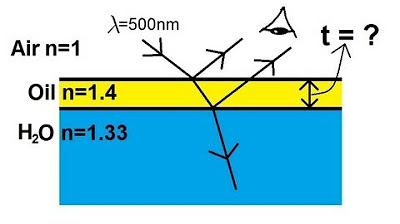
Physics 60 Interference of Light (6 of 8) The Thin Film: Oil
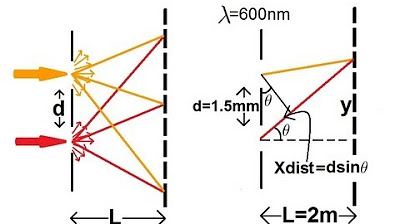
Physics 60 Interference of Light (4 of 8) Young's Double Slit
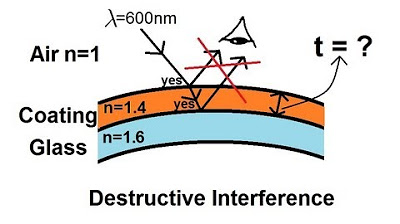
Physics 60 Interference of Light (7 of 8) The Thin Film
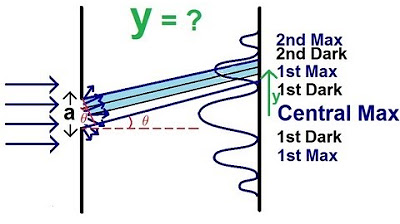
Physics - Diffraction of Light (1 of 4) The Thin Slit
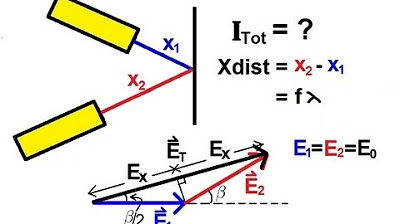
Physics 60 Interference of Light (3 of 8) Path and Phase Difference: General Case
5.0 / 5 (0 votes)
Thanks for rating: